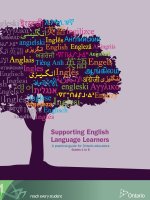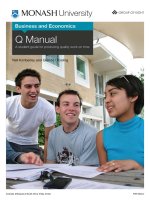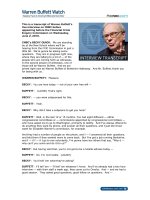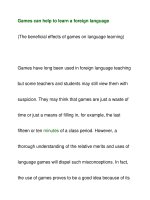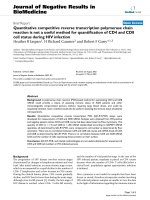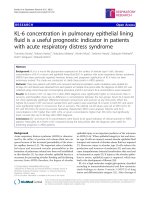New proficiency testbuilder
Bạn đang xem bản rút gọn của tài liệu. Xem và tải ngay bản đầy đủ của tài liệu tại đây (2.28 MB, 13 trang )
Scanned by
N ew Proficiency
Testbuilder
Mark Harrison
セ
MACMILLAN
lhv author would like ttl thank Lena Hauberg. Denise Coufalova. Anja Ferstl,
ChdJ'lotk Hnnstrorn. Andrca 7s Toth. Eva Orieskova and Luisc Kloss for
providing the- -cun ph- ,1Ils\\'CLS for Papers 2 and 3.
ani! RCI1lity by Arthur Ma rwick, Harpc-Collm-, Publishers Ltd (p114); TIll'
Random House Group for Extract from Cfll::'s by Jilly Cooper, published by'
Methuen. Used by permission of The Random House Croup Ltd (p llfi):
News International Syndication for all extract from 'Cl'tting the bird' by A. 1\.
A. A. Cill/TinlL's Newspapers
Gill in The Sunday Tinic-, 15 June 1997,
Limited (1997) (p13l); The Random House Croup for all e-xtract from Swillg
i lamnter Sioing' by Jeff Torrington, published by Martin Seckel' & \Varhurg.
Reprinted by permission of The Random House Croup Ltd (pI31); Penguin
Books (UK) for an extract from X-Ray by Ray Davies (Viking, 1994) Copyright
Ray Davies, 1994 (p133) and for an extract from f ャ Q ゥ エ O セ ヲ ゥ ャ ャ ャ by Marianne
Faithful! with David Dalton, Michael Joseph (1994) Copyright (', Mananne
Faithfull, 1994 (p134); The Random House Croup for an extract from TIlc
l-?ailway Mall by Eric Lomax, published by Jonathan Cape. Reprinted by
permission of The Random House Group Ltd (pBS); Ncw-, International
Syndication for an extract from 'Rainmaker with his head in the clouds' by
Anjana Ahuja in The Times, 16 February 1998,
Times Xcwspepcr-, Limited
(1998) (p136); The Random House Croup for an extract from OI:'IT l!It' Limit by
Bob Monkhouse, published by Century. Reprinted by permission of The
Random I louse Group Ltd (p13S); Dyson Appliances Ltd for an extract from
'The slow arrival of the wheel' by James Dyson, Q Q W Q Q Q Q G ' { I y s H Q i Q G N . ス A ゥ N セ ャ エ j ョ n of Creal
Illllcn!iolls, Part 1, 2000 in Telegraph maga:ine (pl St}, Telegraph Croup Ltd for
an extract from 'Frantic Semantics: Bogus' by' John Morrish in Tdcsrapl1
IIll1gl1:ilJc, 4 March 200n (p1S2); Thames & Hudson Ltd for an extract from
l I 」 セ ゥ ァ A ! Since 1945 by' Peter Dormer (]993) (pJS7).
!'Ill' pul-Ie.hor-, would like to thank the staff and students of East Finchley
School or English for their 11l'1p, and Mike Cutteridge and Lynn Gold for their
input.
The author and publishers would like to thank till' Unin'fsity ot C
sheets.
llic author .md publisher-; would like to thank the following for permission
ttl n-prodtm- their material: f ialifu x pic for an extract from 'No place like
hom . ." hv Christine Webb in 1[(lIlIC:; nnd 517Z'illg::;, Summer 1995 (pH); Telegraph
Croup l.td toran e-xtract fromtIurrung Points Number 19, Pennsylvania
St.ruon. Ncvv York by Cites v'lorsley in The 017ily Telegraph Art:; C7' Hooks, 8
Mav ItNt),
It'll'graph Croup Limited (1999) (14); PFD for an extract from
1"111' s エ ア イ r (l( tlit' SUI/ by Caroline I iarvcv reprinted by permission of PFD on
behalf of [l),mlld Trullope.
Caroline Harvey, 1983 (p14); the Harvill Press for
excerpts from 5(ltt CitI/ i(') jonathan Raban, '1974. Reproduced by permission of
the I t.irvill l'rcs-, (ppl;, D2); 1\111 Macmillan for an extract from The Dead (:f
laidl(l bv Colin Dt-xte-r, Sidg\vick &]dckson, Macmillan, London, UK (pIS);
David llighdlll Associates nil behalf of the author for extracts from IlJspector
TlII/llt'l ()/lIl1il'/lS bv Dorothy Simpson, Warner Hooks (1994) (pI6); Pearson
Education Ltd for l'xtr,-lCts from 1"I1t' Pt'l/gllill 1Ii:; tory (:f the United St17tes (if"
Alllcrini uv Illlgh Brog.m. Penguin (1090),
Pearson Education Limited 19H5,
1999, reprinte-d bv pr-nuis-.ion of Pearson Education Limited (pp l S, 88); News
lnte-rnation.tl Svndicanon for an extract from 'Why advertising matters' by
Stephen Armstrong ill lhc Sunday Tinu'< Art ..; Supplelllent, 3D April 2000, C0
Stl"plwil ArlllstronglTillll'S Nl'\vspapers Limited, 2000 (p25); TlIe I leI/dOl/and
llllcfT/l'.l! flrt's:, for ,1Il l'x!r,lC! from 'Tube inspired a book', Die Pre:,::> 27 April
21100 (p2S); Abner Stein on behalf of the author for an extract from the
Forl'\vord bv Dr Anthon!' c ャ \ Z ャ イ ャ l to Vim 17lld Your Adolescellt by L<:lUrl'nCe
セ エ ャ G ゥ ョ 「 ャ G イ r L Q i セ ~ An11 Ll'villl', Ebury Prpss (1992) (p31); rvlic Cheetham Literary
on iwhalf of the <1uthor for an extract from It'cllnger ..; - J\ Fa1l1ily
Cuid,' hI' Lauric Crah<1I11, Chatto & Windus (1992) (p32); Pan
MilClllill,1I) for .11) l'xtract from Spt'IICtT Tracy by Bill Davidson, Sidgwick &
Jackson, r-d,lClllilL1I), London, UK (p50); Penguin Books (UK) for an extract
fnm1 Jlt'crlt'.N N [ ; rIot:'
Est]lL'r Freud (I lam ish Hamilton, 1993) Copyright (l)
Esther Freud, Il)l)J
lane Furnival for an extract from 'The most
!ilwr,lting gddgl't C\'l'r?' in Vv'('ckelld Tdegrapll, S September 1998; News
Intl'rnatitHl,ll Syndicltioll for an extract (rom 'Game for a laugh' by Simon
BiH1WS in '1"111' Tllllt'''; /v1/\1 S/lPfJlt'lIl1'llt, 9 October 1999, ({) Simon Barnes/Times
:'\V\VSp,lper.. . Limi!l'd (Il)Yt)) (p52); Little, Brown and Company (UK) for an
l'\.tLlCt frnnl ...;/Ii.lliliS U/J by Rick Gekoski, (1998) (pS2); Mainstream Publishing
Cll. Ltd {or .111 l'),Jr
\1d.dgl'n, セ G [ ゥ 、 I M M G L | | G ゥ 」 c & J,lckson, Macmillan Ltd, London (p,57); HlJke
rricdlll.lnil litcrdfV
on behalf of the author and The Random House
Croup for dn l':\.tr.;ct
ttl Trade by Michael Ridpath, published by
\Villi,lm Ileilll'm<lI1n. Rl>printed by permission of The Random House Croup
Ltd (p:;9); C'pventrv ((l/'l/iJlX Tcll'Xnlpll for an l'xtract from 'King of the
w.ltchmtlkcrs' b-,,' Mdrk f ッ イ ウ エ エ N セ イ r 12 Fd,ruary 2000 (p67); International
ThoJllson Publishing Sen'icl's Ltd (or an extract from Lbllta:,talldillg Popular
CII/tllft' by John FiskL', U'Hvin Hy'man (19H9) (p72); News International
S\'ndic,ltioll lor ,1Il l'xtrdct fmm 'Tlw I-Iorse's Tale' by Rachel CampbellIl'lhnstol1 in TlI1' Tilllc." /'v1aXII:i!lC, 21 June 1997, Times Newspapers Ltd (p86);
l'l'nguin nooks (UK) fur illll'xtrcKt fmm g H I N N [ セ ゥ ー ヲ イ ッ ャ ャ ャ Thrush Green by Miss
HC,ld (Michael Joseph, 198])
19tn by Miss Read (p87); The Orion
Puhlishing Croup Ltd for .ln l'xtract from KClllleth vVilliallls by Michael
Frl'edland, VV'L'idcnldd & Nicoboll (1990) (pH8); Transworld Publishers,
Kate Atkinson. t:xtr<:lctcd from filillWI! Croqllet, published by Black Swan,
.1 division o( Trans\\'orld Publishers. All rights reserved (p89); TIll' Orion
Publishing (;roup Ltd for .1n extr<:Kt from 'The Pawn King' by Dominic
L.l\vsun in /v1(1n' Tllal/ iI CII/llt', CQ Oil SpOft ed. Philip Watson, The Orion
Publishing Croup Ltd (pl)7); Tclcgt\lph Croup Ltd (or an extract from
'Celebrity crosSOVt'r' by Tim Dm,vling in Telegraph nwgazine, 26 February lOOO,
ft.'legr,lph Croup Limited (p107); Atlantic Syndication for an extract from
'Hero sunk by .1 lust tl)r stardom' by Roger Deakin in Mail 01/ Slfllday RI'vic'lv,
2,; June 2000 (pIOS); f LlfperCollitb Publisht'rs for an extract from Cla%: [mage
The author and publishers would like to thank thl" follovving fur permission to
reproduce their material Oil cassette: Telegraph Croup Ltd fur l'xtrdcts from
the following: 'It's a dirty job, but if he didn't do it.. ' by Ionnv Bc.u'dsall in
TclcSTl1ph '0/c('kclld, 5 June 1099 (p7S); 'H
]l'IL'graph Croup
Limited (999); 'Are you a maven or a connector?' by Damian Thompson in
The Daily Telegraph Arts S Roob, 6 May 2000, Telegraph Croup Limited
(2000) (p38); David Higham Associates on behalf of the author for an extract
from 'C'mon man - get a grip' by Geoffrey Wall in
lVI't'k1'l1l1,26
September 1908 (p38); Kogan Page for an extract (rom
III
Hotel
/utmini-tr.nionond lv1mlllgcIIlcllt by Russell Joseph, Russl'll Joseph,
Kogan Page Limited (p43) and for an extract from c ャ ャ ョ G サ G イ r ill Hdl/ililiX by
Loulou Brown, l.oulou Hrown, 1997, Kogan Pagl> Limited (p45); Abner Stein
on behalf of the authors and The Random House Croup for an extract from
Getting to Yc.s by Roger Fisher and William Ury published by Hutchinson.
Used by permission of TIll' Random House Croup Limited (pp72-1); Anna
fox and Roger Highfield for an extract from "Seeing is be!in'ing .- any
moment now. 'in TIlL' Daily 'ldcgnlplJ, Zti April 200n (p76); Michael O'MarJ
Books Ltd on behalf of the author for extracts from} }(Ji(' I}oll.':;e!/(Jld Nmllcs
Rcgl1l1 (1997) (pp77, 1(2); Atlantic Syndicdtion for an extr,lCt from '\'\'1..' lived
\vithout TV for a year - and lovl'd it' by Miranda Ingram ill Daily ;,\'1/1il, 17
August 2000 (pHO); F&W Publications, Inc., excerpted fwm 5I1ul's.. . fill
Scriptwritins copyright 1991 by Jurgan VVolft and Kerry Cox. Used \vith
permission of Writer's Digest Books, and imprint of F&V\' Publicatiolls, Inc.
All rights reserved (pHI); Atlantic Syndication for extr,lcts from 'Cheer up, life
can only get キ ッ イ ウ ・ セ ~ by Quentin Letts in Daily ;,\117il, 21 June 2000, '\\'hat's
cooking?' by Rosie Shepherd in
t"'-r Day, 18 June 200{) (pll9) and 'More
than <:l game' by Stephen ferns in
Stal1dard
25 February
loon (pI20); Dyson Appliances Ltd for an extract from
we need a nevI"
patl'nt law' by James Dyson, 1111Ilt':; Dy:;(lll ':,
Part 3,
Introduction, 2000 in 1L'lcgraph lIIagazinc (p120);
Burt for
20 April 2000,
'( wouldn't
from R.OOlII
Enigma (2000),
Paddy Burt (pI22); Sheldoll Press for an
extract from How to llllpnmc YOllr c o A セ ヲ ゥ 、 エ G i ャ H エ t by Dr Kenneth Ilambly (]Y87)
(p160); Telegraph Croup Ltd (or extracts from 'C
think 1 have a way with pain' by Will Cuhu in The Dail.l! ldl'grapll /1rts & Hook:;,
6 MilY 2000 (pI6l),
Tl'lcgrilph Croup Limited (2000), and 'Rhythm 'n' roilds'
by Mick Brown in 'ldcgmph Thrucl, 20 Novl"mber 191.)9 (pI61), (:"'1elegr
Macmillan Education
Between Towns Road, Oxford OX4 3PP
A division of Macmillan Publishers Limited
Companies and representatives throughout the world
i s i ャ l
0 III 9549H X
o III 95497 I
(with key)
(without key)
Tl'xt
Mark Harrison 2002
Design and iliustr.uion
Macmillan Publishers Limited 2002
First published 200:?
All righh reserved: no p.u-t of this publication may be reproduced, stored in a
n-trioval svstl'll1, t-an-nutted ill anv form, or bv anv means, electronic,
ュ ャ G 」 ィ 、 ャ ャ ゥ 」 N セ ャ l photocopying, recordtng, or otherwise. without the prior wri tten
permission of the publisher-;
Dl'sig[ll'd by Xcn Mcdi., Ltd
COH'r dt'sign bv Xcn Me-dia l.td
V'lhilst every effort has been madc to tracL' mvncrs of copyright matl'rial in
this book, there may have been somc cases v','hell thl' publi..;her..; have been
unable to contact the o\tvners. V'le should be gratPt"ul to lW<:H from anvone \\'ho
recognises copyright material and \vho is unacknowledgl'd. V'll' ..;hall be
pleased to make the necessary amendments in futurl' editiOlb {If thl' book.
The authors and publishers \vould like to thank tIll' fo]]o\ving for permission
to reproduce their photographic material:
Mary Evans Picture Library pl76 (c); The Hulton Archive' pp176 (d, b); Image
Bilnk pl71 (d); Pietor pi 72 (b); Superstoek ppl71 (c), 172 la, e); Stone pl71 (a),
174 (a), 175 (d, e); Telegraph Colour Library pl71 (b, d), 17.1 (e), 174 (b, c).
Printed and bound in Spain
by Edelvives
2006 2005
10 9 8 7 6 5
CONTENTS
INTRODUCTION
TEST ONE
PAPER 1
Further Practice Paper 1 Part One
8
10
PAPER 2
Further Practice Paper 2 article
21
PAPER 3
20
25
26
Further Practice Paper 3 Part One
Further Practice Paper 3 Part Five
33
PAPER 4
Further Practice Paper 4 Part One
38
40
PAPER 5
Further Practice Paper 5
46
48
TEST TWO
PAPER 1
Further Practice Paper 1 Part Two
50
54
PAPER 2
Further Practice Paper 2 review
61
PAPER 3
Further Practice Paper 3 Part Two
Further Practice Paper 3 Part Five
66
68
74
PAPER 4
Further Practice Paper 4 Part Two
75
78
PAPER 5
Further Practice Paper 5 Parts Two
82
and Three
84
63
4
TESTTHREE
PAPER 1
Further Practice Paper 1 Part Three
86
92
PAPER 2
Further Practice Paper 2 proposal
Further Practice Paper 2 letter
99
100
104
PAPER 3
107
Further Practice Paper 3 Part Three
Further Practice Paper 3 Part Five
110
116
PAPER 4
Further Practice Paper 4 Part Three
119
123
PAPER 5
127
Further Practice Paper 5 Parts Two
and Three
129
TEST FOUR
PAPER 1
Further Practice Paper 1 Part Four
131
140
PAPER 2
Further Practice Paper 2 essay
Further Practice Paper 2 report
143
144
148
PAPER 3
Further Practice Paper 3 Part Four
151
155
Further Practice Paper 3 Part Five
159
PAPER 4
Further Practice Paper 4 Part Four
160
165
PAPER 5
Further Practice Paper 5
167
169
KEY AND EXPLANATION
177
LISTENING SCRIPTS
255
Sample answer sheets
267
Assessment criteria - Papers 2, 3 and 5
270
4
INTRODUCTION
THE NEW PROFICIENCY TESTBUILDER
The New Proficiency Testbuilder is much more than a book of Practice Tests. A completely new version
for the Revised Proficiency exam in operation from December 2002, it is designed not only to enable
students to do tests of exactly the kind they will encounter in the exam itself, but also to provide them
with valuable further practice, guidance and explanation. This will enable them to prepare thoroughly for
the exam and increase their ability to perform well in it.
The New Proficiency Testbuilder contains:
Four complete Practice Tests for the Cambridge Certificate of Proficiency
in English
These tests reflect exactly the level and types of question to be found in the exam.
Further Practice and Guidance pages
These are included for each part of each paper and they come immediately after the part of the exam
they relate to (see Contents). For each part of each paper, they include What's Tested sections, which
provide detailed explanations of the precise focus of each part of the exam, and Tips sections, which
provide advice on the best approaches to answering the questions. Throughout these pages, students
are encouraged to draw their own conclusions as to what the correct answers to the questions in the test
are, and the step-by-step approach taken enables students to develop and apply the right processes
when answering the questions in the exam.
For PAPER 1 READING, the Further Practice and Guidance pages contain exercises and questions
directly related to the questions in the test.
For PAPER 2 WRITING, the Further Practice and Guidance pages provide outlines enabling students to
plan their answers. They also contain samples of each kind of writing that may be included in the exam
(article, report, etc) for students to assess.
For PAPER 3 USE OF ENGLISH, the Further Practice and Guidance pages contain exercises and
questions directly related to the questions in the test. They also contain exercises for planning the
summary tasks and samples of summaries for students to assess.
For PAPER 4 LISTENING, the Further Practice and Guidance pages contain exercises directly related to
the questions in the test.
For PAPER 5 SPEAKING, the Further Practice and Guidance pages provide exercises on vocabulary
likely to be useful in general terms, exercises on vocabulary relating to the themes for discussion in the
tests and practice in talking about pictures.
INTRODUCTION
5
Key and Explanation
This contains full explanations of every answer to every question in the tests.
For PAPER 1 READING, this section contains detailed explanations not only of the correct choices, but
also of why other options are incorrect. Within these explanations, key vocabulary in the texts is
explained.
For PAPER 2 WRITING, this section contains task-specific mark schemes for each question and
assessments of the sample answers.
For PAPER 3 USE OF ENGLISH, this section contains detailed explanations of the answers to each
question, including grammatical and lexical information, mark schemes for the summaries and
assessments of the sample summaries.
For PAPER 4 LISTENING, this section contains detailed explanations not only of the correct choices,
but also of why the other options are incorrect. Within these explanations, key vocabulary in the pieces
is explained.
For PAPER 5 SPEAKING, definitions are given of the vocabulary in the Further Practice and
Guidance pages.
How to use the New Proficiency Testbuilder
Teachers and students who have the edition with key can use the book in a number of ways:
1 Simply follow the instructions page by page. Clear directions are given as to the order in which to do
things. If you follow this order, you:
• complete one part of a paper, perhaps under exam conditions, and then
either
• do the Further Practice and Guidance pages relating to that part and check the answers to the
questions in those pages. Then review the answers given to the questions in the test in the light of
what has been learnt from doing the Further Practice and Guidance pages. Finally, check the answers
to the questions in the test and go through the explanations of them.
Or
check the answers to the questions in the test and go through the explanations of them if there are no
Further Practice and Guidance pages and
then
• move on to the next part of the test.
2 Vary the order.
You may wish to do some of the Further Practice and Guidance pages before answering the questions in
the test that they relate to. Alternatively, teachers may wish to do the Further Practice and Guidance
pages as discussion or pairwork, or ask students to prepare them before class.
6
INTRODUCTION
The Certificate of Proficiency in English
The following is a brief summary of what the exam consists of. Full details of what is tested in each Part
of each Paper are given in the relevant Further Practice and Guidance pages.
PAPER 1 READING 1 hour 30 minutes
Number
Number
of Questions of Marks
Text
Question Type
1
3 short texts, each with 6 gaps
6 x 4-option multiple-choice
questions per text, testing
vocabulary, 1 mark per question
18
18
2
4 short texts with a linked theme
2 x 4-option multiple-choice
questions per text, testing
comprehension, 2 marks per
question
8
16
3
1 long text with 7 gaps
choosing from 8 paragraphs to fill
each gap, testing text structure and
meaning, 2 marks per question
7
14
4
1 long text
7 x 4-option multiple-choice
questions, testing comprehension,
2 marks per question
7
14
Total
40
62
Number
of Words
Number
of Marks
Part
PAPER 2 WRITING 2 hours
Part
Question Types
1
compulsory, may be an article, letter, essay or proposal
300-350
20
2
choice of one of three options (options are article, letter, proposal,
report, review) or choice of one from three set book questions*
300-350
20
*Candidates can choose from three set books, which are specified in
the exam regulations each year. Since the set books change from year
to year, these have not been included in this book.
Total
40
PAPER 3 USE OF ENGLISH 1 hour 30 minutes
Task
Question Type
1
1 short text with 15 gaps
filling each gap with one word,
mostly testing grammar, 1 mark
per question
15
15
2
1 short text with 10 gaps
filling each gap with one word
formed from the word given,
testing word formation, 1 mark
per question
10
10
3
6 sets of three sentences, each
with a gap
filling the gaps with one word
that is appropriate in all three
sentences, testing vocabulary, 2
marks per question
6
12
Part
Number
Number
of Questions of Marks
INTRODUCTION
7
4
8 sentences to be rephrased
rephrasing the given sentence
using a word supplied and the
beginning and ending supplied,
testing vocabulary and grammar,
2 marks per question
8
16
5
2 short texts, each with two
questions
Summary writing task
write answers to the two
comprehension questions on each
text, 2 marks per question, and
write brief summary of both texts
4
8
1
14
Total
44
75
PAPER 4 LISTENING approximately 40 minutes
Piece
Question Type
1
4 short pieces
2 x 3-option multiple-choice
questions per piece, testing
comprehension, 1 mark per
question
8
8
2
1 longer piece, usually a
monologue
9 sentences to complete with
information given in the piece, 1
mark per question
9
9
3
1 dialogue, often an interview
5 x 4-option multiple-choice
questions, testing comprehension,
1 mark per question
5
5
4
1 discussion involving two
speakers
6 x matching views to speaker
expressing them (sometimes
views are expressed by both
speakers), 1 mark per question
6
6
28
28
Part
Number
Number
of Questions of Marks
Total
PAPER 5 SPEAKING 19 minutes (usually two candidates and two examiners)
Part
Activity
Length
1
conversation between examiner and each candidate on general and
social matters
3 minutes
2
talking about pictures, followed by conversation between candidates
on topic arising from one or two of the pictures
4 minutes
3
each candidate talks for two minutes, based on prompts given to them
on a card; candidates then discuss with each other and the examiner
the topics related to the prompt cards for eight minutes
12 minutes
Marks
20
Marks are worked out so that each paper is worth 40 marks. This gives a total of 200 marks, which can
be divided by two to give a percentage. To pass, candidates need to score approximately 60%.
8
PAPER 1
TEST ONE
PART ONE
TEST ONE
PAPER 1 READING 1 hour 30 minutes
PART ONE
For questions 1-18, read the three texts below and decide which answer (A, B, C or D) bestfits each gap. In the
exam you will mark your answers on a separate answer sheet.
Living in Flats in Britain
The British have never (1)
to flat dwelling in the way that other Europeans have. This is
probably because of the English Channel. Continental European city dwellers had to build walls to keep
out marauding invaders. Those who farmed the city hinterlands would (2)
inside the walls and
close the gates when danger approached. Space within the walls was at a (3)
, so it made sense
to pile one home above another in the form of flats. Flats were the (4)
in cities like Paris from as
early as the 15th century. Apart from the odd Viking, invaders were kept from British shores by the sea,
allowing the British to live in houses (5)
across the countryside in villages, hamlets and market
towns, the only city of any size at that time being London. It was not until the industrial revolution
started (6)
people off the land into towns in the late 18th century that there was a demand for
mass housing. Then, rooms in houses were rented by the poor and each family would share one room.
1
A fallen
B run
C taken
D given
2
A dash.
B expedite
C gush
D inundate
3
A rarity
B shortcoming
C dearth
D premium
4
A average
B norm
C par
D yardstick
5
A messed
B scattered
C littered
D sprayed
6
A luring
B eliciting
C spurring
D inciting
Meeting Marvin Gaye
When I first met Marvin Gaye in his Sunset Strip studio, I had just completed a two-year project
co-writing the autobiography of Ray Charles, an inspiring collaborator, but an authoritative and often
(7)
figure. Marvin came on like a brother. He was warm, witty and (8)
to laugh. He
spoke like he sang, in whisper-quiet melodies and soft falsettos. His conversation had a lyricism all of its
(9)
His affectations - a slight British accent when he was feeling aristocratic, for example -
were more than (10)
by his disarming sincerity. We became friends. I felt (11)
to watch
PAPER 1
TEST ONE
9
PART ONE
him work and play up-close. It soon became clear that, like his music, his personal life was filled with
dramatic contradictions, a combination of charm and chaos. Because he was a hero of mine, and because
his art was so dazzlingly beautiful - so self-contained, so accomplished, so (12)
slick - it took
me a while to realize my hero was drowning.
7
A distant
B faint
C secluded
D far-away
8
A prompt
B abrupt
C impulsive
D quick
9
A type
B self
C like
D own
10
A set against
B weighed up
C made up for
D settled up with
11
A advantageous
B privileged
C indulgent
D gainful
12
A appreciably
B fully
C utterly
D sorely
Sir John
Sir John did not seek to belittle and undermine for the sake of it. It was easy to mock - (13)
, it
was the instinctive reaction of any thinking being to the modern world - but great harm could be caused
by thoughtless mockery. His intention was merely to instil a little humility. He was fighting a
(14)
battle, he knew. His colleagues - the psychiatric, the teaching and the social work
professions - were all doing their (15)
everybody was (16)
to raise people's self-esteem. It was their basic credo;
by low self-esteem. For Sir John, on the other hand, the self-esteem of most
of the men and women he came across was far too high for their own (17)
, or anybody else's,
already. The job of the professors was not so much to promote the uncontrolled expansion of self-esteem
(18)
to forcibly ram it back into the Pandora's box from which it should never have been
liberated, and then sit upon the lid.
13
A in that case
B indeed
C to that end
D still
14
A losing
B failing
C defeating
D wasting
15
A bounds
B excess
C lengths
D utmost
16
A afflicted
B sustained
C undergone
D grieved
17
A behalf
B avail
C good
D interest
18
A except
B so
C as
D just
Before you check your answers to Part One of the test, go on to pages 10-13.
10
PAPER 1
FURTHER PRACTICE AND GUIDANCE
PART ONE
WHAT'S TESTED
Part One of the Reading Paper focuses on vocabulary. Questions may test any of the following:
·
·
·
·
·
·
semantic precision - choosing the word with the right meaning in the context. This does not involve
completing a phrase or deciding according to grammatical structure; you must simply decide which
option has the correct meaning in relation to the meaning of the sentence or the text as a whole.
collocation - choosing which word goes together with another or others to form a phrase. It may be
possible to fill the gap with another word that is not an option in the question, but only one of the
words given as an option correctly completes the phrase.
complementation - choosing the option that fits grammatically. More than one of the options may
have the right meaning but only one will form a grammatically correct structure.
idioms - phrases that have a special meaning as phrases, which may differ substantially from the
meaning of the individual words in them. Questions testing idioms involve choosing which single word
completes the idiom.
fixed phrases - phrases in which the individual parts are always used together, and in which the
meaning can be logically worked out from the meaning of the individual words in them. Questions
testing fixed phrases involve knowing which single word completes them.
phrasal verbs - phrases consisting of a verb followed by a preposition and/or an adverb which have
a special meaning that cannot be worked out simply from the meaning of the verb. Questions may
involve choosing which single word completes a phrasal verb or choosing from a set of complete
phrasal verbs.
linkers - words or phrases that connect sentences or parts of sentences. Questions testing linkers
involve choosing from single-word linkers, deciding which word completes a linking phrase or
choosing from complete linking phrases.
TIPS
•
Read the text very carefully to make sure that the options you choose make sense in terms of the
meaning of the text. If you only focus on a few words immediately before or after a gap, you may
incorrectly choose an option that might seem to fit grammatically and in isolation, but does not fit in
the context of the text.
• Make sure that the option you choose fits grammatically. It may be that more than one of the options
fit the meaning of the text but that only one fits in grammatically.
• Don't choose an option simply because it looks like the 'hardest' word or because it is the only one
that you don't know. The correct option may be a relatively simple word, though not used in a simple
phrase or with its simplest meaning.
In each of the exercises below, choose which of the four options fits into each of the four sentences.
Each exercise relates to the question with the same number in the test, and the options are the
same as those given for that question in the test. This will help you to eliminate some of the
incorrect options in the test or to confirm that you have selected the correct option.
Living in Flats in Britain
1
I fallen
run
taken
A Tim has always been
B Louise has
C Graham has
D Julie has always
given
to dreams he has no hope of achieving.
to life in her new country as if she'd been born there.
into the habit of forgetting promises he has made.
to her friends whenever she has a problem.
FURTHER PRACTICE AND GUIDANCE
2
I
dash
expedite
gush
PAPER 1
inundate
A The pipe broke and water started to
B To
3
I
around to get everything ready for the trip in time.
Fans started to
rarity
out of it and onto the floor.
the bureaucratic process, I contacted the manager direct.
C I had to
o
the box office as soon as the tickets went on sale.
shortcoming
dearth
premium
A Lack of patience is her main
I
in her dealings with people.
B Ann got a job easily because people with her experience were at a
C Instances of that disease are a
o
norm
of young talent in sport these days.
par
I
yardstick
A His work became the
by which everyone else's was measured.
B In this society, such behaviour is the
, it's not an exception.
C My earnings at that time were well below the national
5
I
Sudden changes are
scattered
messed
littered
B The room was
sprayed
I
with champagne.
with the remains of the previous night's party.
C All my plans got
6
up because other people let me down.
His office was untidy, with papers
luring
eliciting
spurring
around allover the place.
inciting
A Recent wins have been
the team on to play better and better.
B I wrote them several letters, without
a response.
C It was said that troublemakers were
o
..
for the course in this company, as I've learnt.
A When he opened the bottle, everyone got
o
.
in this day and age.
There is definitely a
4 I average
o
the protesters to riot.
Clever advertising has been
people into taking up this offer.
Meeting Marvin Gaye
7 I distant
faint
secluded
far-away
A It is hard to warm towards someone who is so
B They gave me only a
She had a
with everyone else.
outline of the project they had in mind.
C Fame caused her to lead a rather
o
PART ONE
life, in her own private world.
look in her eyes, as if something was troubling her.
11
12
PAPER 1
8
prompt
PART ONE
abrupt
impulsive
A Frank is
and makes promises without thinking about the consequences.
e
Hazel has a very
o
I think it's important to be
I
type
quick I
to blame other people when something goes wrong.
B He's
9
FURTHER PRACTICE AND GUIDANCE
self
manner, which many people find rude.
like
in replying to letters and messages.
own
I
A There was amazing scenery, the
B People of his
e
o
10
I
of which I had never seen before.
would lie to anyone if it was to their advantage.
The island is unlike any other, as it has an atmosphere all its
After a bad patch, Helen is back to her old
set against
weighed up
A When I'd
again, I'm glad to say.
made up for
settled up with
I
both sides of the argument, I made my decision.
B I hope this present has
11
.
the fact that I forgot your birthday.
e
When the cost was
o
She paid for both of us and I
I advantageous
the benefits, the scheme looked good.
her when we got home.
privileged
indulgent
gainful
A Doing this course might prove
I
to me in my future career.
B She has rather
parents, who give her everything she asks for.
e
o
when he was made captain of the national team.
He said he felt
It took James some time to find
121 appreciably
fUlly
utterly
employment when he left college.
sorely
I
A When Sally leaves this department, she will be
B I think they're
e
o
I was
missed.
brilliant and they're my favourite group.
expecting to have a bad day, but it turned out all right.
Her health is
better than it was a week or so ago.
Sir John
131 in that case
indeed
to that end
A You can't come on Friday? Well
B I haven't got much money;
e
o
I don't think you made a mistake;
She wanted promotion and
still
, we'll have to meet another day.
, things could be a lot worse.
, I would have done the same.
she set about impressing others.
